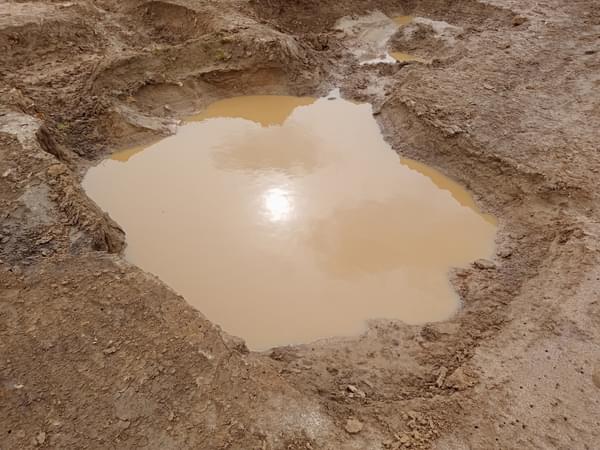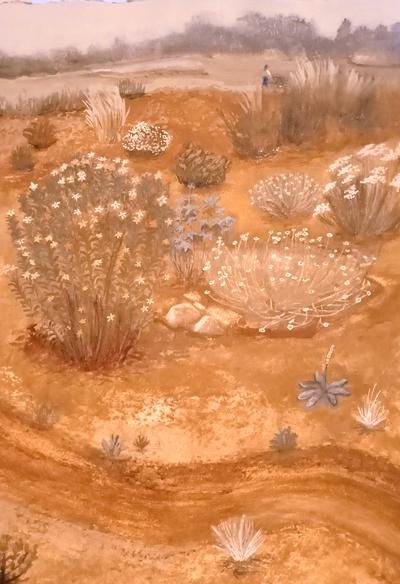Jenny Mellings

In previous years my activity involved selecting and processing fragmentary images from multiple sources, including those related to our engagement with the virtual world of the internet. Throughout earlier work there has been a dominant theme of the layering of imaginary visions onto representations of perceived reality, which continues into newer work that has sprung from various different sources.
At this point (2024), I’m currently making works on paper in response to a particular site close to my home where there has been an archaeological dig in progress. This involves documenting the site (and the archaeologists activities) through photography and drawing. A more imaginative response to the site as it changes is then made through painting. This correspondence will continue as the area eventually transforms into a new housing estate. There is layer-upon layer of history beneath the soil (from bronze age life, through Roman to medieval) which has slowly been uncovered, so much new work going forward will relate to various aspects of this as well as the new life that will eventually continue in that location. It also incorporates desert-like places - subject matter that has appeared in my work before, for example in the form of landscapes of other planets and composite images of architectural elements. Other key themes include the altered botanical landscape in the area of the excavations. Plant prints and studies have been central to much of the work made so far.
For the past few years I have increasingly used natural pigments for painting (both found and also commercially prepared). These range from local earth colours to lapis lazuli and Egyptian Blue. Recently I’ve also made drawing ink with oak galls and walnuts from the vicinity of the dig. Foraged earth also goes particularly well with watercolour paper, particularly Khadi paper, which is my preferred surface.
Earlier I made many paintings on Khadi paper including a series relating to Calais Jungle camp (following a volunteering visit there in early 2016), an East Devon Way commission of 25 paintings in 2018. During the pandemic from 2020-22 my palette turned almost exclusively to blue as cyanotype techniques were combined with painting with lapis lazuli, other blue pigments and watercolours. Now the colours have changed again with continuing work relating to the landscapes of other planets, south coast of England seascapes and the nearby, rapidly evolving archaeological excavation.
Some much earlier pieces involved the appearance of motifs derived from 'emoticons' commonly used in email exchanges. They were used as 'vessels' for the containment of themes related to, or in contrast or conflict with the background image, and paintings were arranged in formats which are derived from computer screen window layout. Later the confines of the traditional rectangular surface format was fractured in favour of smaller 'components' which can be freely arranged across a supporting surface. Much of their content is based upon visual and other material received via the web in various contexts, but is not confined to those sources. Alongside ideas related to sensory overload in my work, there has been perhaps a stronger thread that is much more to do with the opposite. Recently I've been considering ideas surrounding the knowledge that sensory deprivation can induce such phenomena as visions and many other experiences in which the brain can compensate for lack of stimuli arriving through all the senses. Of course such happenings in people's lives vary from religious visitations, visual and auditory hallucination, and waking dreams, memories or intrusive thoughts that can temporarily override reality. This relates very much to current work as I repeatedly visit an area of landscape where real evidence of the lives of previous inhabitants of my town are being rediscovered, providing much stimulus for the imagination.
In the past I have also worked with such ideas by means of film/stop-motion animation in which drawing has been overlaid onto and developed from an underlying photograph. By doing so, I was able to extend sequential narrative in a reflexive and spontaneous way, and these kinds of processes may be taken up again at some point. Some earlier work was related to the effects of war/conflict. This has not been consciously maintained as a guiding force, but appeared more as a result of being subject to media influences. An early film (Crisium) completed in autumn 2003 was based on the idea of earthly visions animated against a lunar landscape, for which resources included appropriated images from historic engravings and also from the news. It partly rested on the idea that either an image or a landscape empty of life could each generate a response in the form of a flood of visual images, and sometimes words to the brain. During the past year I have returned again to using landscapes from beyond our physical reach, those of untrodden other planets visible only through high technology. Currently in 2024, the churned-up earth of the archeological site with its odd shaped pits and strange markings somehow relate to inter-planetary landscapes and have a similar mystery about them and tendency to trigger ‘visions’.
Previously I painted in a roughly Expressive/Surrealist style and frequently made narrative, allegorical works with mythical references and some images appropriated from ancient art. Influences Traditional European figurative painting (particularly landscape), prehistoric and multicultural art, contemporary film and photography, animation, painting, drawing, the internet, life in general both on my doorstep and the furthest reaches of the known world!
As for other work, In the past I have led art clubs for children and young people at Spacex Gallery, Exeter, and also at other venues such as the Royal Memorial Museum, Exeter, CCANW, Plymouth Arts Centre, and Thelma Hulbert Gallery. My role at Plymouth University as Associate Lecturer in Fine Art was between 2005 -2015 (also was a visiting lecturer in fine art and illustration previously). Additionally, I taught History of Art A level at Exeter School from 2003-2006, and have run animation workshops for 'Animated Exeter' and related events from 1999 to 2009 in various schools and institutions, helping young people to create short animated films some of which were shown at First Light, Young Co-Operative Filmmakers and other events. From 2021-2023 I was lead artist in a Culturally Chard project (initiated by SAW) and have also been involved with exhibitions and workshops in the Somerset area from 2019-2024.
Residency/commission: Banners of Chard (lead artist) 2021-2022, Group exhibition: Moving Waters, Terre Verte Gallery 2024, Cornwall, Landscape (Re) View at Taunton Brewhouse 2024, Solace at Musgrove Park Hospital 2022, Group exhibition: Noticeboard at OSR projects, West Coker 2021, Group Exhibition: Nature Reimagined at Yeovil Artspace 2021, Group exhibition: In pursuit of Spring at Black Sawn Arts, April 2021, Group exhibition: Somerset Reacquaited at Somerset Rural Life Museum, On the Ground at Common Ground, Oxford, February/March 2020, Group exhibition: LANDE, The Calais 'Jungle' and Beyond, 2019, Group exhibition: GROUNDED at Cotley Tythe Barn, 2019, SAW Bursary artist 2019, RECAPTURE , East Devon Way artist comission and group exhibition:Experiencing the Landscape 2018. On the Ground at Christmas Steps Gallery, Bristol, April 2018, Visions in Confinement in the historic cells at Devonport Guildhall 2018, Canteen at TOPOS 2018, The Garden Room Gallery, Dartington (Art.earth), 2018, On The Ground at the Chapel in the Garden, Bridport 2017, On the Ground at Plymouth Art Weekender 2017, Plymouth Contemporary Open 2017, Group exhibition: The Observatory, Exeter University 2017, SAW Open Studios, 2012, 2014 and 2016 - SAW Open Studios, SAW, Goldfinch Place, Crewkerne, TA18 7AG Group exhibitions 2014 - Recollections Thelma Hulbert Gallery 2012 - Wheels of Wonder, Visual Art Centre, Lincolnshire 2009 - film screening, Spacex Gallery, Exeter 2007 - Experimental Film and Video Festival 700is, ASU Alsager Gallery , Manchester Metropolitan University 2007 - film screening, 700is Experimental Film Festival, Egilsstadir, Iceland 2006 - Drawing Losing Your Mind (Saison Video), LAAC, Dunkerque 2005 - Hull International Film Festival, outdoor venue, Hull 2005 - Start Moving Image Festival, Plymouth Arts Centre, Plymouth 2004 - Homeland, Spacex Gallery, Exeter 2002 - Drawn Conclusions, Plymouth City Museum and Art Gallery, Plymouth 1999 - Spacex Gallery, Exeter 1993 - Compendia, small works by invited artists, Spacex Gallery, Exeter 1992 - Breakthrough, Victoria Art Gallery, Bath 1992 - News, women artists from the south-west, Spacex, touring to Truro 1991 - Four painters, Austin Desmond Fine Art, Huxham, Devon 1990 - Austin Desmond Christmas Show, Huxham, Devon Curated projects 2002 - Super 8Station, Station, Bristol Residencies 2008 - B-Side 3 minute films by 4 artists, PVA Medialab , Bridport Dorset 2004 - Residency during William Kentridge exhibition, Spacex Gallery, Exeter Other 2007 - 7001S, Film Festival, Eglisstadir, Marsh Award winner for excellence in Gallery Education 2013.
Helping Artists Keep Going
Axis is an artist-led charity supporting contemporary visual artists with resources, connection, and visibility.














